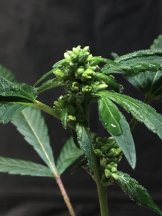mastodonGenentix
Master Dons Seeds
Cs or Sts for reversing your ladies.. Also open to talking about your DIY Sts formulas.

Yellowish? Mine comes out being clear.The solution is suppose to come out yellowish.
I made the first batch with greater voltage, got a lot of erosion of the silver and solid deposits.Yellowish? Mine comes out being clear.

??? Huh? Silver particles are heavier than water, no matter how you slice itThe particles that are the right size should stay suspended for quite a while. I would give it some more time. Not like it can hurt.
But light particles take a long time to drop.??? Huh? Silver particles are heavier than water, no matter how you slice it

Horse shit.The solution is suppose to come out yellowish.
But light particles take a long time to drop.
"The particles are so small that they resist gravity and stay suspended. "
And only these gravity-defying particles matter?
More Horse Shit. Why isn’t the stuff you buy yellow with shit floating in it? Are they doing it wrong too?
No, more like piss. I did not think the same but the second time around without the erosion of the first run I did had it come out yellow. Might be dependant on the voltage used for it to come out that way, I don't know. But that was said on other forums and I ended up with the same. But as they say, if it works it is good. So whatever you got is fine with me.Horse shit.
You screwed up the quote so I did not catch your last bit. Here is some information for you from commercial sellers of it, some pretty pictures from papers on it also. In the video you posted at 12:10 he also says that you want an amber color. Are you always rude when challenging people when you are wrong?printer said:
But light particles take a long time to drop.
"The particles are so small that they resist gravity and stay suspended. "
And only these gravity-defying particles matter?
More Horse Shit. Why isn’t the stuff you buy yellow with shit floating in it? Are they doing it wrong too?




You screwed up the quote so I did not catch your last bit. Here is some information for you from commercial sellers of it, some pretty pictures from papers on it also. In the video you posted at 12:10 he also says that you want an amber color. Are you always rude when challenging people when you are wrong?
Silver Nanoparticles: Optical Properties
"Unaggregated silver nanoparticles will have a yellow color in solution. If the particles aggregate, the solution with appear grey."
The Effect of Size on Optical Properties
The optical properties of spherical silver nanoparticles are highly dependent on the nanoparticle diameter. The extinction spectra of 10 sizes of NanoXact Silver nanoparticles at identical mass concentrations (0.02 mg/mL) are displayed in the figure below. Smaller nanospheres primarily absorb light and have peaks near 400 nm, while larger spheres exhibit increased scattering and have peaks that broaden and shift towards longer wavelengths (known as red-shifting).


Silver Nanoparticles: Optical Properties
Silver nanoparticles absorb and scatter light with extraordinary efficiency. Their strong interaction with light occurs because the conduction electrons on the metal surface undergo a collective oscillation when they are excited by light at specific wavelengths. This oscillation is known as a...nanocomposix.com
Colloidal or Ionic Silver - what is the difference?
Colloid by definition means ultrasmall particles dispersed in a continuous medium (liquid in our case) whose properties depend on the large specific surface area. Ionic by definition means atoms, that are missing an eletron, or have an extra electron. Most products advertised as “colloidal silver” contain mostly silver ions, not silver particles, so technically they are silver solutions, not silver colloids.
Visually it should be quite easy: colloid silver is represented by a yellow-to-brown colour, where the hue depends on concentration of silver and the particle size (or the age of the product respectively). Ionic silver products are transparent, the presence of silver ion can be easily verified by adding of the kitchen salt (NaCl) which results in formation of non-soluble silver chloride (AgCl represented by white turbidity). Products manufactured by electrolysis (AC, DC, high or low voltage) are typicaly ionic silver solutions, not colloids.
Colloidal Silver | NANOIRON
nanoiron.cz
Biosynthesis of silver nanoparticles from glycyrrhiza glabra root extract

Colloidal silver in various stages of aggregation, (A) clear yellow sol, (B) dark yellow sol, (C) violet sol , and (D) grayish sol, as aggregation proceeds
UV–visible spectroscopy was used for quantification of silver nanoparticle synthesis.
Colloids consist mainly of large nanoparticles having nearly spherical shape particles of size 20–
30 nm. It is clear from the images (Fig. 2 and 3) that the particles in colloid are well-dispersed
with a more uniform size 20 nm.
The Color of True Colloidal Silver
True colloidal silver is never clear like water because silver nanoparticles absorb light at a wavelength of 400 nm causing the liquid to have an amber color when observing a light source through the liquid. The darkness of the amber color is a general indication silver nanoparticle concentration. A five PPM product will appear light amber and a twenty PPM product will appear a much darker amber. A fifty PPM product will appear almost black. Just because a product is amber does not necessarily mean it is true colloidal silver. Ionic silver solutions made by electrolysis can appear amber or dark amber due to very large particles but without having particle concentrations above 50 percent.

Know the Truth About True Colloidal Silver and How to Identify It
Reading a label is one way to know a product, but can you trust the words? Learn the truth about True Collodal Silver.www.silver-colloids.com

Horse shit.
Obviously not.More Horse Shit.
Yes wonderful, I’m glad that I taught you something.Wonderful that it worked for you. But others have had failures with the method. I gave information that might help others and I gave real scientific explanations where it comes from.
Obviously not.
